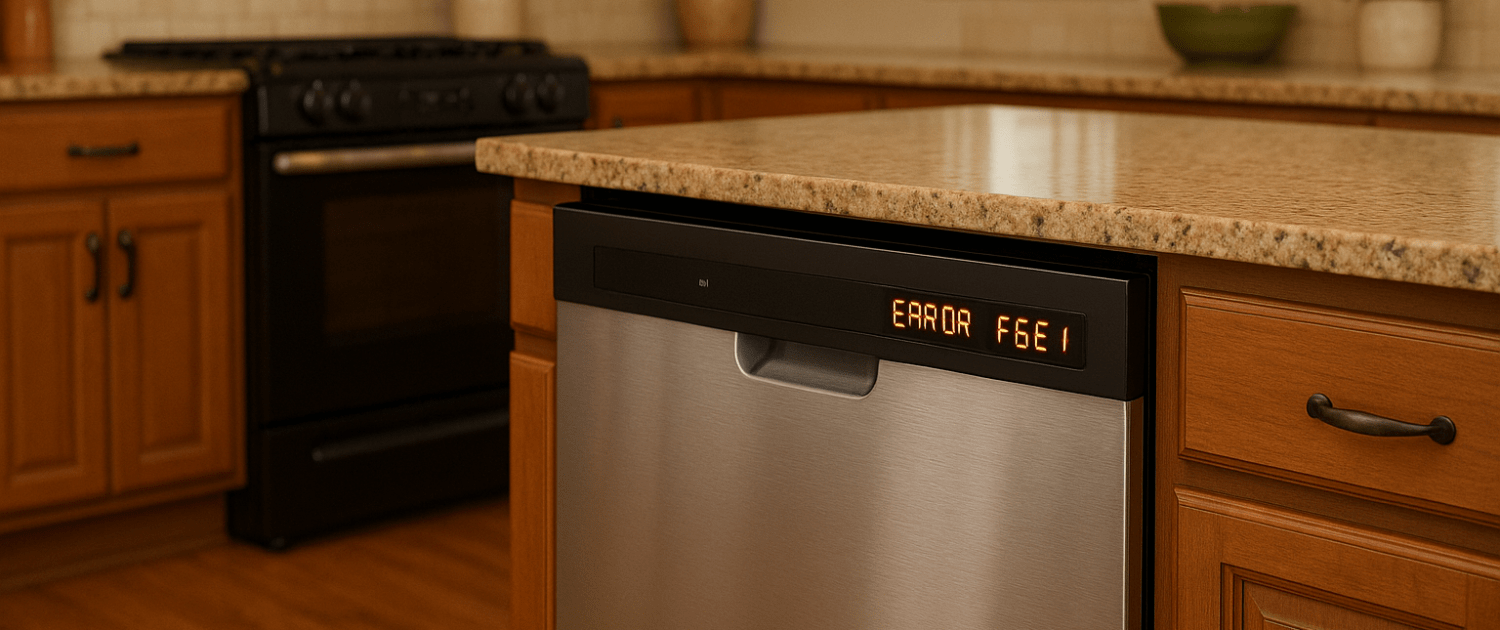How to Fix Whirlpool Dishwasher Error Code F6E1
Steven E / Thursday May 8, 2025
So your Whirlpool dishwasher is flashing F6E1 and refusing to fill with water? Whether it’s a kinked hose, clogged filter, or a bad inlet valve, we’ve got a quick and easy troubleshooting guide to help you get things flowing again. Let’s dive in!
If you find out that you need any replacement parts for your appliance while you’re troubleshooting, you can enter your model number at AppliancePartsPros.com to order them. Most orders arrive in just two business days, and we have thousands of free guides to show you how to install your new parts.
The information in this article may not apply to your specific appliance model. We recommend consulting your manufacturer’s documentation or contact us with any questions.
Understanding the error code
The F6 E1 error code in a Whirlpool dishwasher signifies a problem with water filling.
F6 (or 6 flashes) – Not filling
The F6, often represented as six flashes on your dishwasher control panel, is an error code indicating a failure in water filling. This means that your Whirlpool dishwasher experiences difficulty drawing adequate water into its system during a wash cycle.
A multitude of reasons could be responsible for this problem such as issues with the inlet valve or even a faulty motor control unit that directs and controls the flow and amount of incoming water. Additionally, it can be something such as the optical water indicator or flow meter on rare occasions.
It’s crucial to diagnose this issue promptly because, without a sufficient water supply, your appliance would have trouble accomplishing thorough dish cleaning.
Common causes of the error code
Water inlet valve
A crucial part of your dishwasher is the water inlet valve. This part governs the amount of water allowed into your dishwasher tub during each wash cycle. If this component either malfunctions or becomes clogged, it can trigger the error code.
Blocks in flow can occur due to mineral build-ups or debris disrupting its function and preventing the appropriate water level from being reached for a thorough cleanse and potential build-up of dirty water. It’s also possible that over time, wear and tear may have caused mechanical failure within the valve itself.
Regular maintenance can go a long way in preventing these issues, ensuring that an optimal volume of incoming water reaches your machine for every wash cycle.
Motor or pump
These parts play an essential role in circulating and draining water during the wash cycle.
If either of these parts is malfunctioning, your dishwasher may not fill or empty correctly, leading to the error. A common sign of motor or pump failure includes unusual noises during operation—sounds that weren’t present before could be your cue to investigate further.
Control board
A faulty control board can often be the culprit behind the error code. The control board acts as the brain of the dishwasher, coordinating all its functions.
When it malfunctions, it can cause communication issues between various components of the dishwasher. In some cases, a relay failure on the main control board.
Safety precautions
When working on any appliance, remember to keep safety first. Here are some tips to keep in mind:
- Always power off and unplug your appliance or switch off the circuit breaker before attempting any maintenance or replacement work. This keeps you safe by preventing any risk of injury from electric shock.
- Wear insulated work gloves to protect your hands from sharp metal parts, pinching hazards and debris.
- Take your time and don’t rush while working to prevent accidents and personal injuries.
- Work in a well-lit area so you can clearly see and access the interior parts.
- Clear your workspace of clutter and other obstacles. Keep children and pets away from the work area.
- Never work on internal parts with bare wet hands. Make sure the work area is completely dry.
- Check your user manual to see if there are specific installation or safety instructions for your part or appliance.
- Be gentle when handling or removing parts. Excessive force might damage the appliance or cause injury.
- Wear safety glasses when working with chemicals, dust or cleaning large debris to prevent injury.
- If the appliance has recently been used, give it plenty of time for any heating parts to cool down before working on it.
- Take pictures or make a note of wiring terminals or other connections before disconnecting to prevent any problems with reassembly.
- When working with wires, avoid touching any exposed wires or terminals. If you need to touch a wire, use a non-conductive tool or wear insulating gloves to prevent electrical shock.
Troubleshooting steps
To resolve the F6 E1 error code in your Whirlpool dishwasher, follow these troubleshooting steps:
Step 1: Inspect and clean the water inlet valve
- Before inspecting the water valve, make sure to turn off the power supply to the dishwasher by unplugging it or switching off the circuit breaker.
- Depending on your specific Whirlpool dishwasher model, you may need to remove the top panel or access panel to reach the inlet valve. Consult your dishwasher’s manual on accessing this component.
- Carefully examine the water inlet hose connected to the valve for any signs of clogging or blockages. If you notice debris or mineral deposits, these can restrict water flow.
- Use a soft brush, such as a toothbrush, to gently scrub away any dirt, debris, or mineral deposits from both ends of the inlet valve and its connectors. Take care not to apply excessive force that could cause damage.
- Once you have thoroughly cleaned the water valve, reconnect both the power and water supply connections securely.
- Turn on your dishwasher and run a test cycle to check if the error code returns. If it does not reappear, it indicates that cleaning the water inlet valve has resolved the issue.
Step 2: Examine the motor or pump
- Before starting any repairs, ensure that the dishwasher is disconnected from the power source to prevent any electrical accidents.
- Depending on your dishwasher model, you may need to remove the top panel or access the motor from the bottom of the unit. Consult your dishwasher’s manual for specific instructions.
- Check for any loose wires or connections around the motor and pump area. If you find any, secure them tightly.
- Use a multimeter to test the motor for continuity. Check if there are any open circuits or signs of damage that may indicate a faulty motor. If necessary, replace the motor with a compatible part.
- Check for blockages: Examine both the intake and drain hoses connected to the pump for any clogs or obstructions that may be preventing water flow. Remove any debris if present.
- The impeller blades inside the dishwasher’s pump can become clogged or jammed over time. Carefully remove and clean them, ensuring they spin freely without resistance.
- After cleaning and reassembly, test the fill pump and drain pump by running a diagnostic cycle or regular wash cycle on your dishwasher.
- If after performing these steps, you still encounter problems with your dishwasher’s motor or pump, it might require replacing faulty parts.
Step 3: Troubleshooting the control board
- Before attempting any repairs, always disconnect the power to the dishwasher to ensure safety.
- Remove the top panel of your dishwasher to gain access to the control board. Refer to your dishwasher’s manual for specific instructions on how to remove the top panel.
- Check all wiring connections on the control board for any loose or disconnected wires. Reconnect any loose wires securely.
- Inspect the control board for any signs of burnt or damaged components, which could indicate a short circuit. If you find any, it is recommended that you replace the control board.
- If you have identified a fault in the control board during your troubleshooting steps, it will need to be replaced.
Step 4: Resetting the dishwasher
To reset the dishwasher and clear any fault codes or error messages, follow these steps:
- Unplug the dishwasher from the power outlet or switch off the circuit breaker that supplies electricity to it. This will ensure that the dishwasher is completely powered down.
- Leave the dishwasher disconnected for at least 5 minutes. This allows any residual power in the system to dissipate.
- Plug the dishwasher back into the power outlet or switch on the circuit breaker. Make sure that it is properly connected and receiving power.
- Close the dishwasher door and select a test cycle. Start the cycle and let it run for a few minutes before canceling it. This helps to reset the control board and clears any
- After resetting, check if the error code has been cleared on your dishwasher.
Additional information
Thank you for reading! We hope this guide helped you get your dishwasher working again.
If you have any other appliance repair needs or projects, don’t hesitate to explore our other troubleshooting guides and videos.
If you need replacement parts or some extra help with ordering them, grab your model number and head over to AppliancePartsPros.com, where you can chat with a pro, read our DIY blog and more.
Be sure to subscribe to us on YouTube and follow us on Facebook, Twitter and Instagram!
With nearly a decade of experience in providing top-notch customer service regarding appliance parts and repair, Steven enjoys sharing practical advice, troubleshooting tips, and interesting information to help readers stay informed.





